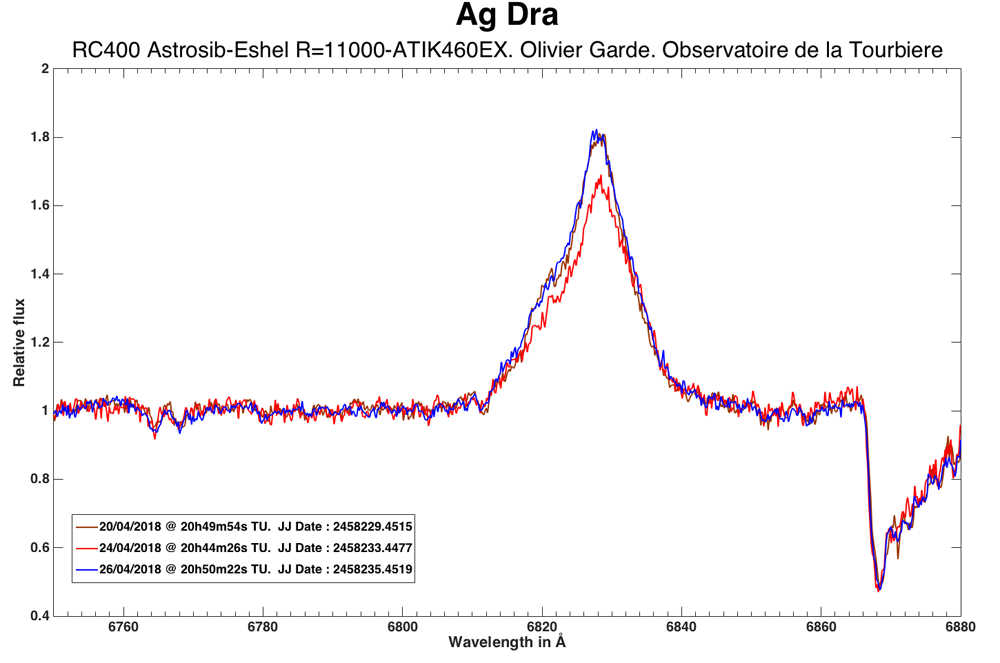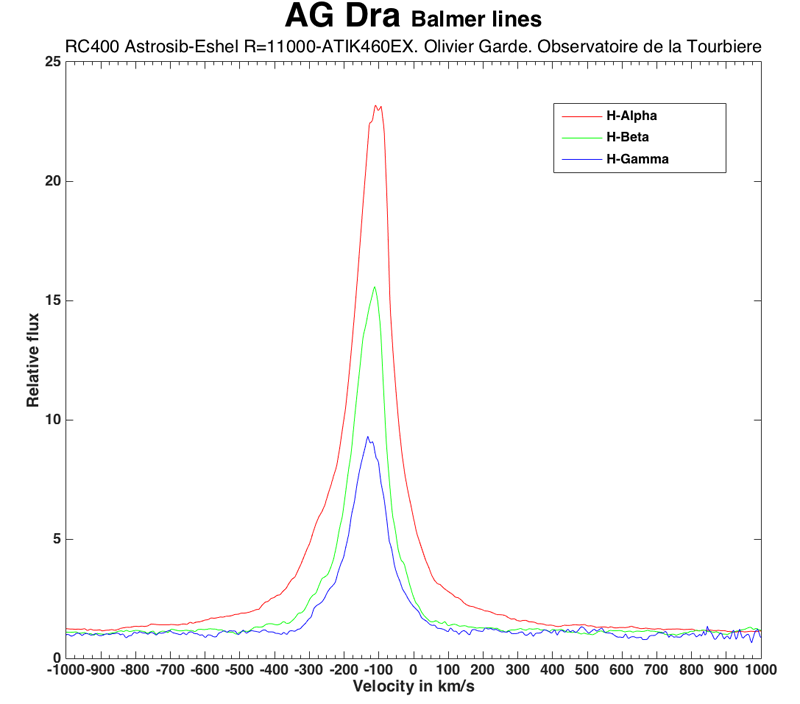Call for monitoring of AG Dra by R. Galis & al.
-
umberto sollecchia
- Posts: 247
- Joined: Tue Dec 30, 2014 3:25 pm
Re: Call for monitoring of AG Dra by R. Galis & al.
Bonsoir à tous, placez ma contribution dans la région H-Alfa.Umberto
-
Christian Buil
- Posts: 1432
- Joined: Mon Sep 26, 2011 6:59 pm
- Contact:
Re: Call for monitoring of AG Dra by R. Galis & al.
Comparison of 23.9/04 and 26.8/04 observations :


Christian


Christian
-
Olivier GARDE
- Posts: 1271
- Joined: Thu Sep 29, 2011 6:35 am
- Location: Rhône Alpes FRANCE
- Contact:
Re: Call for monitoring of AG Dra by R. Galis & al.
Here is the comparison of AG Dra on 3 nights.

Something stange appear on the 26th : we see that the profile of the Raman line returned to its initial state of the 20th.
So, what happened on April 24th ?

Something stange appear on the 26th : we see that the profile of the Raman line returned to its initial state of the 20th.
So, what happened on April 24th ?
LHIRES III #5, LISA, e-Shel, C14, RC400 Astrosib, AP1600
http://o.garde.free.fr/astro/Spectro1/Bienvenue.html
http://o.garde.free.fr/astro/Spectro1/Bienvenue.html
-
Daniel Dejean
- Posts: 127
- Joined: Sun Sep 18, 2016 7:20 am
Re: Call for monitoring of AG Dra by R. Galis & al.
Hello,
I am very impressed by what I see on this forum on AgDra alert. Not sure about the value added of my comment based on low resolution data. It a obviously a great challenge for my Alpy600 on a SkyWatcher 200/1000 with Atk428 camera (4.5microns/pixels)... After a first (and poor) tentative with bin22 on 24/04 I did a second trial on 26/04 with bin11 (cf data base record 26/04/18 DDJ). Result appears better and more reliable.
Looking to these low resolution data I can see a significant doppler blue shift on the main lines. Based on a chart below it can be evaluated at about 140km/s for Hgamma and HeI 4686. It appears to be slightly lower for Halpha around 110km/s. The measurement resolution is estimated by ISIS is around 512, in such condition, the best measurement error level is probably around +/-30kms. Then I am not sure of the real meaning of these measurement at low resolution.
Is there a real blue shift around 130km/s for AgDra or a just an calibration error on my side ? If real, what is the physical reason behind such effect ?
Many thanks for any comment.
Great sky !
Daniel


I am very impressed by what I see on this forum on AgDra alert. Not sure about the value added of my comment based on low resolution data. It a obviously a great challenge for my Alpy600 on a SkyWatcher 200/1000 with Atk428 camera (4.5microns/pixels)... After a first (and poor) tentative with bin22 on 24/04 I did a second trial on 26/04 with bin11 (cf data base record 26/04/18 DDJ). Result appears better and more reliable.
Looking to these low resolution data I can see a significant doppler blue shift on the main lines. Based on a chart below it can be evaluated at about 140km/s for Hgamma and HeI 4686. It appears to be slightly lower for Halpha around 110km/s. The measurement resolution is estimated by ISIS is around 512, in such condition, the best measurement error level is probably around +/-30kms. Then I am not sure of the real meaning of these measurement at low resolution.
Is there a real blue shift around 130km/s for AgDra or a just an calibration error on my side ? If real, what is the physical reason behind such effect ?
Many thanks for any comment.
Great sky !
Daniel


-
Olivier GARDE
- Posts: 1271
- Joined: Thu Sep 29, 2011 6:35 am
- Location: Rhône Alpes FRANCE
- Contact:
Re: Call for monitoring of AG Dra by R. Galis & al.
Daniel,Daniel Dejean wrote:Is there a real blue shift around 130km/s for AgDra or a just an calibration error on my side ? If real, what is the physical reason behind such effect ?
The shift is "normal" and real because of the proper motion of this star, around -147 km/s (see Simbad), so the star go in our direction with a velocity of 147 km/s
http://simbad.u-strasbg.fr/simbad/sim-b ... BAD+search
So if you have remove heliocentric velocity from your spectrum, the shift found in your case with an Alpy is good and real (with a resolution about R=600, the error is about +/-40 km/s).
See the graph made with a resolution about R=11000

LHIRES III #5, LISA, e-Shel, C14, RC400 Astrosib, AP1600
http://o.garde.free.fr/astro/Spectro1/Bienvenue.html
http://o.garde.free.fr/astro/Spectro1/Bienvenue.html
-
Daniel Dejean
- Posts: 127
- Joined: Sun Sep 18, 2016 7:20 am
Re: Call for monitoring of AG Dra by R. Galis & al.
Thank you Olivier,
I was not sure to get enough accuracy in my calibration process to measure such a "small" shift (everything is relative...) with my Alpy600.
This is a great new.
Daniel
I was not sure to get enough accuracy in my calibration process to measure such a "small" shift (everything is relative...) with my Alpy600.
This is a great new.
Daniel
-
Francois Teyssier
- Posts: 1565
- Joined: Fri Sep 23, 2011 1:01 pm
- Location: Rouen
- Contact:
Re: Call for monitoring of AG Dra by R. Galis & al.
Daniel, Olivier a raison en ce qui concerne la vitesse radiale de AG Dra, très élevée
Pour AG Dra, nous avons à la fois des spectres Echelle et des spectres basses résolution
C'est une excellent moyen de vérifier les spectres BR
Pour le 24/04, sur des spectres non corrigés de la vitesse héliocentrique: La position de Ha dans le spectre d'Olivier est 6560 A (-125 km/s, mesure à mi-hauteur de la raie)
Donc, du même ordre de grandeur que la vitesse héliocentrique du système. Note: pour différentes raisons (rotation, zone où se forme la raie ...) il y a souvent un décalage entre la mesure de vitesse de la raie et celle du système.
Dans le tien, on trouve 6464 A, soit un décalage significatif, *vers le rouge*
Ta calibration spectrale doit pouvoir être améliorée. 1 A d'écart serait un résultat correct.
Bonne continuation
François
Pour AG Dra, nous avons à la fois des spectres Echelle et des spectres basses résolution
C'est une excellent moyen de vérifier les spectres BR
Pour le 24/04, sur des spectres non corrigés de la vitesse héliocentrique: La position de Ha dans le spectre d'Olivier est 6560 A (-125 km/s, mesure à mi-hauteur de la raie)
Donc, du même ordre de grandeur que la vitesse héliocentrique du système. Note: pour différentes raisons (rotation, zone où se forme la raie ...) il y a souvent un décalage entre la mesure de vitesse de la raie et celle du système.
Dans le tien, on trouve 6464 A, soit un décalage significatif, *vers le rouge*
Ta calibration spectrale doit pouvoir être améliorée. 1 A d'écart serait un résultat correct.
Bonne continuation
François
François Teyssier
http://www.astronomie-amateur.fr
http://www.astronomie-amateur.fr
-
Daniel Dejean
- Posts: 127
- Joined: Sun Sep 18, 2016 7:20 am
Re: Call for monitoring of AG Dra by R. Galis & al.
Bonjour François,
Tu as tout à fait raison et j'en étais arrivé à la même conclusion après mon premier essai du 24/04. C'est pourquoi je me suis remis au travail le 26/04. Mon commentaire ci-dessus faisait bien référence à ce dernier enregistrement. Sur cet enregistrement du 26/04, voici un donc zoom sur la région Ha en comparaison du spectre d'Olivier. La calibration est meilleure et commence à ne pas être trop ridicule par rapport à ce que l'on peut voir sur un spectre haute définition ...

Dans les deux cas, spectres à haute et basse résolution le blue shift en Ha parait plus bas que celui sur Hbeta et Hgamma (-105 au lieu d'environ -140km/s). Mais bien sûr je n'oublie pas que de toute façon mes résultats obtenus avec un Alpy sont impactés par une incertitude d'au moins +/- 30km/s ce qui rend cette remarque discutable dans mon cas.
Merci à toi d'avoir accepté à la fois le premier essai et ce second tir corrigé. Ceci donne lieu à un échange très instructif et me donne des perspectives d'améliorations.
Bon ciel,
Daniel
Tu as tout à fait raison et j'en étais arrivé à la même conclusion après mon premier essai du 24/04. C'est pourquoi je me suis remis au travail le 26/04. Mon commentaire ci-dessus faisait bien référence à ce dernier enregistrement. Sur cet enregistrement du 26/04, voici un donc zoom sur la région Ha en comparaison du spectre d'Olivier. La calibration est meilleure et commence à ne pas être trop ridicule par rapport à ce que l'on peut voir sur un spectre haute définition ...

Dans les deux cas, spectres à haute et basse résolution le blue shift en Ha parait plus bas que celui sur Hbeta et Hgamma (-105 au lieu d'environ -140km/s). Mais bien sûr je n'oublie pas que de toute façon mes résultats obtenus avec un Alpy sont impactés par une incertitude d'au moins +/- 30km/s ce qui rend cette remarque discutable dans mon cas.
Merci à toi d'avoir accepté à la fois le premier essai et ce second tir corrigé. Ceci donne lieu à un échange très instructif et me donne des perspectives d'améliorations.
Bon ciel,
Daniel
-
Francois Teyssier
- Posts: 1565
- Joined: Fri Sep 23, 2011 1:01 pm
- Location: Rouen
- Contact:
Re: Call for monitoring of AG Dra by R. Galis & al.
Oui, Daniel, ta calibration du 26/04 est impeccable
Bonne continuation,
François
Bonne continuation,
François
François Teyssier
http://www.astronomie-amateur.fr
http://www.astronomie-amateur.fr
-
Peter Somogyi
- Posts: 420
- Joined: Sun Jul 13, 2014 8:56 am
Re: Call for monitoring of AG Dra by R. Galis & al.
Last night 04.30 I've caught Raman lower than on 04.28 (unlike for many past few days till 04.28 till the EW is the same for many days):
Also caught similar fade with a small flicker within a night on 04.21 evening (have an overnight serie).
Have multiple series from more nights (with bad luck: only 208.04.21 so far that showing something), I'm on preparing a more comprehensive report, will send results later.
Weather got poor here, but someone else might catch a further fall.
Peter
Have multiple series from more nights (with bad luck: only 208.04.21 so far that showing something), I'm on preparing a more comprehensive report, will send results later.
Weather got poor here, but someone else might catch a further fall.
Peter